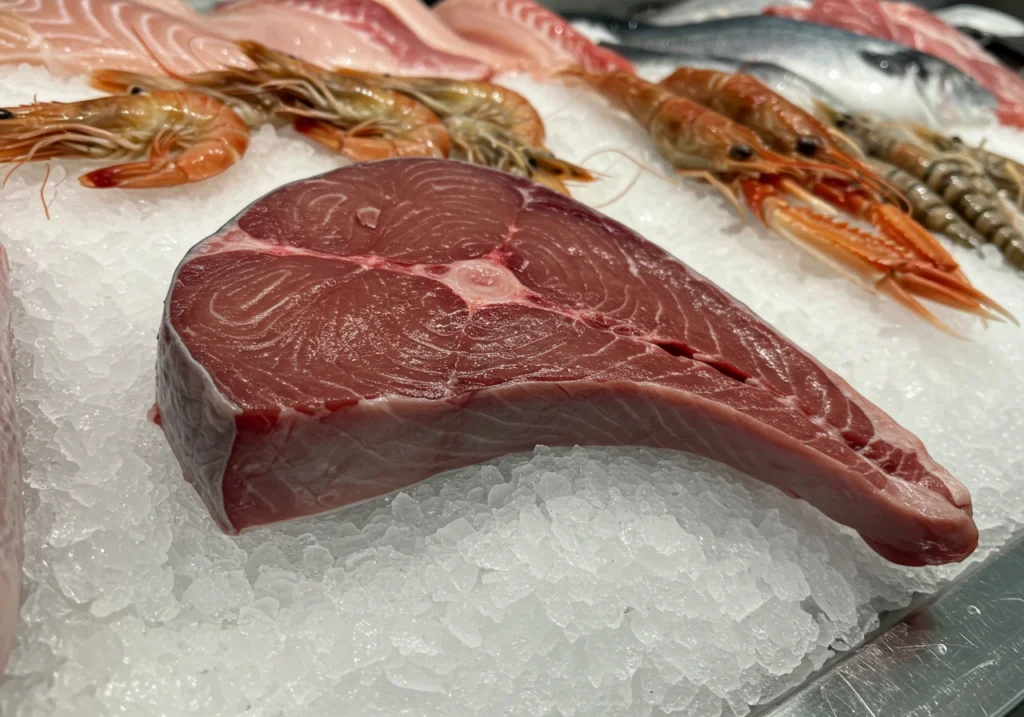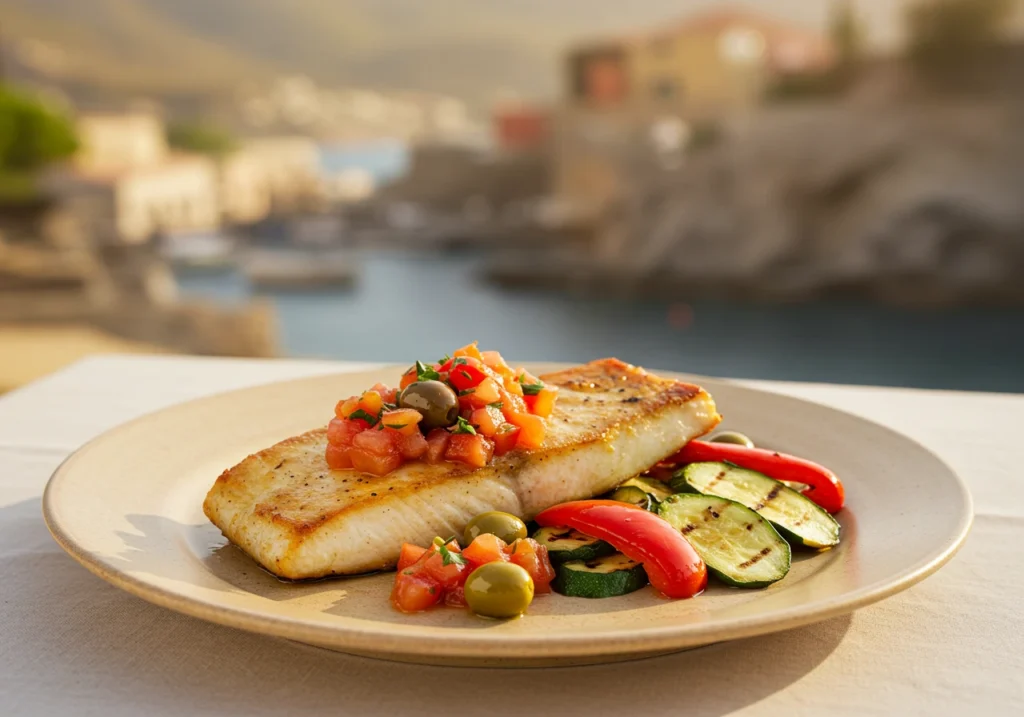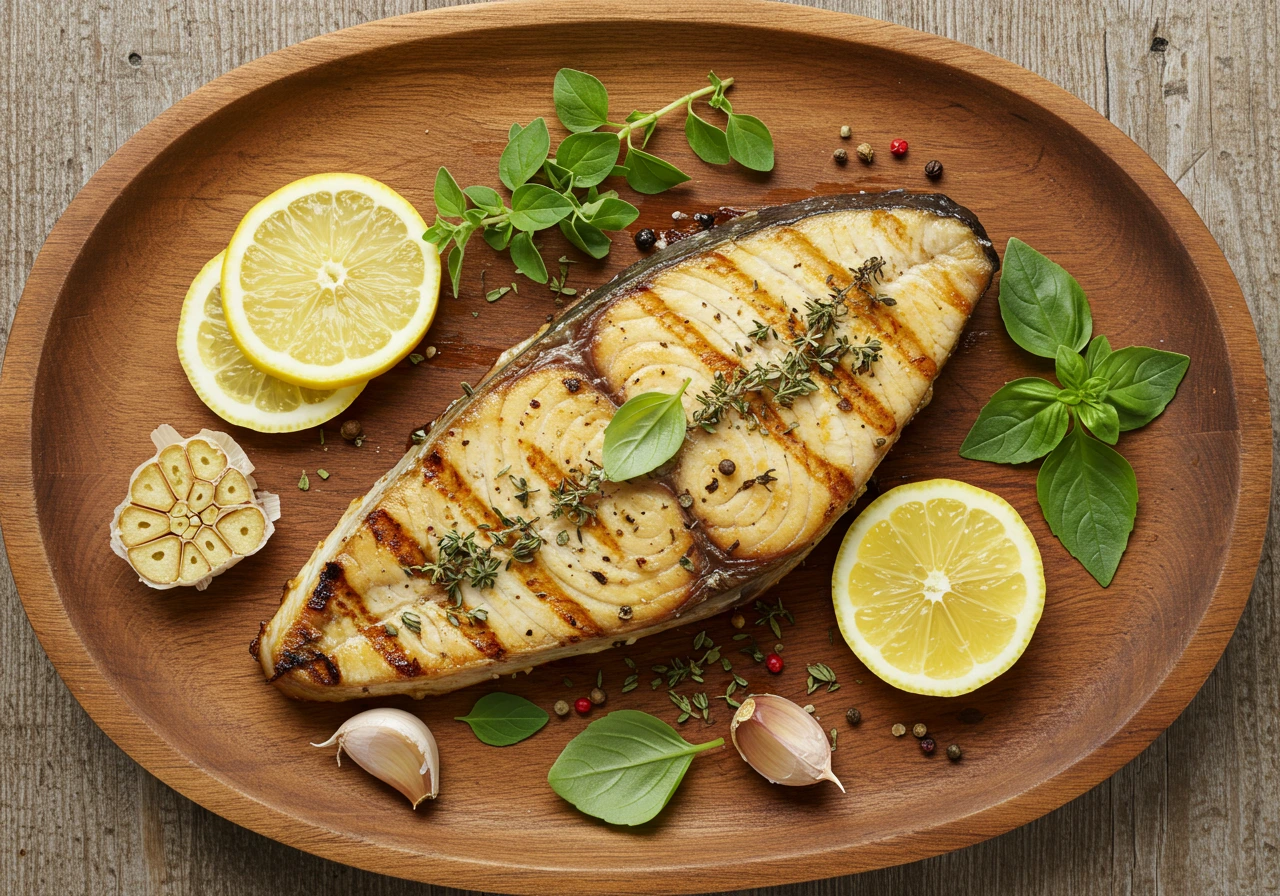Introduction
Craving something bold and flavorful yet surprisingly easy to prepare? You’re in for a treat! This comprehensive guide to the perfect swordfish recipe is your one-stop resource for everything from choosing the freshest cuts to nailing the juiciest sear. Whether you’re a culinary novice or a seasoned seafood lover, we’ll walk you through each step — including grilling, baking, and even Mediterranean-inspired dishes.
You’ll also discover nutritional benefits, my personal take after trying out a few recipes, and answers to all those “what ifs” you’ve likely Googled. So, grab your apron, because things are about to get deliciously fishy — in the best way!
Part 1: Discovering the Perfect Swordfish Recipe
Why Swordfish Deserves a Spot in Your Kitchen
Swordfish isn’t just any fish — it’s the heavyweight champion of the sea, both in size and taste. With its meaty, steak-like texture and mild flavor, swordfish is perfect for anyone who usually prefers chicken or beef but wants to ease into seafood. That said, it isn’t just about taste. Swordfish offers a boatload of nutritional perks, making it a popular choice for health-conscious home cooks.
For starters, it’s packed with lean protein, essential B vitamins, and omega-3 fatty acids — nutrients that fuel your body without overwhelming your taste buds. Plus, it’s super versatile. You can grill it, sear it, bake it, or even poach it. Basically, swordfish is the blank canvas every kitchen artist dreams of.
What Makes a Swordfish Recipe “Perfect”?
Ah, the million-dollar question! A perfect swordfish recipe nails three key elements:
- Freshness: Swordfish must be ultra-fresh or properly frozen. There’s no negotiating on this.
- Simplicity: Less is often more. A squeeze of lemon, a pinch of salt, and a drizzle of olive oil can work magic.
- Cooking Technique: Because swordfish is lean, it can dry out fast. The goal is to cook it just right — not a second more.
Ultimately, a great recipe should celebrate swordfish’s natural texture and subtle flavor without overpowering it. And oh yes — it should be easy to follow, even on a weeknight.
How I Got Hooked on Swordfish
I still remember the first time I cooked swordfish at home. I was skeptical — would it be rubbery? Too fishy? But when that golden-brown sear hit the pan, releasing a cloud of garlicky, citrusy aroma? Total game-changer. Since then, I’ve tried countless swordfish recipes, tweaking seasonings and techniques until I found my go-to favorites.
One thing I learned the hard way? Don’t overcook it. Seriously — swordfish isn’t forgiving. But when you get it right? Oh wow, it’s buttery, juicy, and totally addictive.
Benefits of Cooking Swordfish at Home
Sure, you can order swordfish at a fancy restaurant — but why not cook it at home and save a pretty penny? Beyond saving money, making your own swordfish dish allows for total customization. Want it spicy? Mild? Gluten-free? Done. Plus, you get bragging rights. There’s something deeply satisfying about serving a perfectly grilled swordfish steak you made yourself.
Let’s also not ignore the health angle. Store-bought fish meals often come drenched in sauces high in sodium and preservatives. When you’re the chef, you control every single ingredient. So, it’s healthier, cheaper, and (let’s be honest) way more impressive.
Sourcing Swordfish: What to Know Before You Buy
Before you rush to the seafood counter, here’s what you should know:
- Look for bright, moist flesh. It should be ivory or slightly pinkish — no brown spots!
- Smell test? Absolutely. Fresh swordfish should smell like the ocean, not ammonia.
- Prefer wild-caught. It’s often more sustainable and flavor-packed.
Oh, and if you can’t find fresh, don’t fret. Frozen swordfish steaks are a solid backup — just thaw them overnight in the fridge for best results.
What is Swordfish?
Swordfish, known scientifically as Xiphias gladius, is a large, predatory fish with a long, flat bill resembling—you guessed it—a sword. This distinctive bill isn’t just for show; swordfish use it to slash at schools of fish, stunning their prey before devouring them. Cool, right?
These majestic creatures can grow up to 15 feet long and weigh over 1,000 pounds. Despite their size, swordfish are prized for their mild flavor and dense, meaty texture—quite unlike flaky fish such as cod or tilapia. Because of this, they’re often called the “steak of the sea.”
Their flesh ranges from a pale pinkish-beige to a light orange hue, which deepens slightly when cooked. The flavor? It’s rich, slightly sweet, and incredibly versatile, making it a darling of both five-star chefs and weeknight warriors.
Nutritional Benefits and Considerations
Swordfish isn’t just tasty—it’s a nutritional powerhouse. Each serving is loaded with:
- Lean protein to support muscle repair and energy levels
- Vitamin B12 and niacin to boost nerve and brain function
- Omega-3 fatty acids to promote heart health and reduce inflammation
- Selenium, a trace mineral with antioxidant benefits
But before you go all in, here’s a quick caveat: swordfish is also high in mercury, especially larger, older specimens. The FDA recommends that pregnant women and young children avoid swordfish altogether. For the rest of us? Enjoy it in moderation—once a week is usually safe and satisfying.
Common Culinary Uses Worldwide
Swordfish recipes vary from coast to coast and culture to culture:
- In Italy, it’s often grilled and served “alla Siciliana” with tomatoes, olives, and capers.
- Across Japan, it might be marinated in miso or soy sauce, then broiled to perfection.
- In Hawaii, swordfish is popularly smoked or served in poke bowls.
- In North America, it’s grilled like steak and topped with zesty sauces or fruit salsa.
Swordfish’s ability to absorb flavors while maintaining structure makes it ideal for bold marinades, rubs, and sauces.
Selecting Quality Swordfish
Tips for Choosing Fresh Swordfish at the Market
So you’ve got your recipe ready and your appetite roaring—how do you pick the best swordfish?
- Color check: Look for light-colored, moist flesh. A slight reddish hue is normal, but avoid steaks with dull, brown, or dry spots.
- Smell test: Fresh swordfish should smell clean—like ocean breeze, not a fishy funk.
- Touch test: If you can, gently press the flesh. It should be firm and bounce back, not mushy or slimy.
Another good move? Ask your fishmonger when the swordfish was caught or delivered. That little question can save you from bland or borderline-spoiled seafood.
Understanding Different Cuts and Their Uses
Swordfish is most often sold in thick, boneless steaks. These cuts are ideal for high-heat cooking methods like grilling, broiling, and pan-searing. Their thickness (usually about 1 inch) makes them resilient—so they won’t fall apart on the grill like flakier fish do.

Here’s a quick breakdown:
| Cut Type | Best For |
|---|---|
| Steak (bone-in or boneless) | Grilling, broiling, pan-searing |
| Cubed swordfish | Kebabs, skewers, seafood stews |
| Sliced swordfish | Stir-fries, sushi, or poke |
When in doubt, go for the center-cut steak—it’s the thickest, most consistent piece, and honestly, it’s hard to mess up.
Pre-Cooking Essentials for the Best Swordfish Recipe
Before you turn up the heat, it’s crucial to know that great swordfish recipes start well before the pan hits the stove. Preparation is where the magic begins — and trust me, skipping this part could be the reason your fish turns out bland, dry, or even unsafe to eat. So, let’s dive into the essentials of handling, marinating, and seasoning swordfish like a pro.
Proper Cleaning and Handling Techniques
First things first: safety and cleanliness come before flavor. Swordfish is a lean fish, which means it’s more delicate in some ways and needs careful treatment.
Here’s what you need to do:
- Always keep swordfish cold — ideally just above freezing. Never let it sit at room temperature for long.
- Rinse the steak under cold running water to remove any lingering scales or surface slime.
- Pat it dry with a paper towel. This helps with browning later.
- Use a clean, separate cutting board for seafood. Don’t mix it up with your meat or veggies board. Ever.
Once cleaned, store the fish in the fridge until you’re ready to cook — ideally within a day of purchase.
🧽 Pro Tip: Wash your hands and sanitize all surfaces immediately after handling raw swordfish to prevent cross-contamination. Better safe than sorry.
Marinating: Enhancing Flavor and Tenderness
Swordfish is dense and meaty — which makes it a dream to marinate. Unlike flaky fish, it holds up well to bold, punchy flavors. Think citrus, herbs, garlic, and oils.

Here’s a classic citrus marinade to get you started:
- Juice of 1 lemon
- 2 tbsp olive oil
- 2 cloves garlic (minced)
- 1 tsp Dijon mustard
- Fresh thyme or oregano
- Pinch of salt and pepper
Let the swordfish marinate for 30 minutes to 1 hour, max. Any longer, and the acid from citrus can actually start breaking down the flesh too much, making it mushy instead of tender.
Want even more ideas? Check out this incredible swordfish marinade recipe from Bon Appétit that adds a buttery, umami twist that’s totally drool-worthy.
🍋 Insider insight: Acid (like lemon or vinegar) tenderizes, while oil and herbs add richness and depth. Balance both for the best result.
Seasoning Basics for Swordfish
You don’t need to go overboard to make swordfish shine. In fact, minimal seasoning lets its natural flavor speak for itself. At its core, a good swordfish seasoning strategy follows this rule: Keep it simple, but not boring.
Basic go-to seasoning combo:
- Sea salt
- Cracked black pepper
- Smoked paprika (for a kick)
- Lemon zest (for brightness)
Rub it in lightly with olive oil before searing or grilling. Want to elevate it? Add a dry herb blend like herbes de Provence or a touch of cumin for warmth. But please — avoid overpowering sauces. They tend to steal the spotlight from this star-of-the-sea.
Tools and Equipment Needed
Recommended Kitchen Tools for Cooking Swordfish
Swordfish isn’t high maintenance, but having the right tools can make a world of difference. Here’s what you’ll want on hand:
- Sharp chef’s knife – for trimming and slicing
- Fish spatula – for delicate flipping
- Heavy-duty nonstick or cast iron skillet – ideal for a gorgeous sear
- Grill or broiler – for smoky, charred flavor
- Tongs – to gently lift and flip steaks
- Meat thermometer – to nail the internal temp (145°F is perfect)
Optional: a fish press or weighted spatula helps keep steaks flat on the grill, especially handy if the cut is thick.
🔪 Want pro results? Invest in a cast iron pan. It distributes heat evenly and creates that restaurant-quality crust you dream about.
Safety Tips When Handling Raw Fish
Food safety is non-negotiable. Swordfish is no exception, especially since it’s sometimes served only lightly cooked.
Follow these golden rules:
- Wash your hands before and after handling raw fish.
- Use separate cutting boards and knives for seafood.
- Disinfect counters and utensils with warm soapy water or a vinegar solution.
- Never reuse marinade unless you boil it thoroughly (or better yet, make a separate batch for serving).
Swordfish may be hearty, but your kitchen hygiene needs to be spot-on to make sure your delicious dish is also a safe one.
Various Ways to Cook Swordfish
When it comes to cooking swordfish, the sky’s the limit. This firm, meaty fish holds its shape incredibly well, which means you’ve got tons of options — and none of them require a culinary degree. From smoky grilling sessions to gently poached sous-vide steaks, there’s a cooking method for every taste and occasion. Let’s explore each one and figure out how to bring out swordfish’s full flavor potential.
Grilling: Achieving a Smoky Flavor
Grilling swordfish is, without a doubt, a fan favorite. The firm texture of swordfish means it won’t flake or fall apart like more delicate fish. Plus, that open flame? It adds a kiss of smokiness that’s simply chef’s kiss.
To do it right:
- Preheat your grill to medium-high.
- Lightly oil the grates to prevent sticking.
- Brush the fish with olive oil and season with salt, pepper, and herbs.
- Grill for 4–5 minutes per side, depending on thickness.
Want those picture-perfect char marks? Don’t move the fish around too much. Give it time to sear and develop flavor. For more visual flair and inspiration, check out this grilled swordfish tutorial on The Spruce Eats.
🔥 Pro Tip: Marinate with citrus and fresh herbs for an extra zing that pairs perfectly with smoky grill notes.
Pan-Searing: Creating a Crispy Exterior
Not ready to fire up the grill? Pan-searing is your next best friend. It gives you a gorgeous golden crust while locking in juiciness — ideal for anyone craving restaurant vibes at home.
Steps to master the sear:
- Use a cast-iron or stainless-steel skillet over medium-high heat.
- Add a tablespoon of high-smoke-point oil like avocado or grapeseed.
- Pat the swordfish completely dry (moisture is your crust’s enemy).
- Sear for 3–4 minutes per side, until both sides are golden and crusty.
You can finish it with a squeeze of lemon or a drizzle of compound butter. For extra guidance, Chew Out Loud has a brilliant step-by-step for the perfect pan-seared swordfish.
🍳 Insider secret: Don’t overcrowd the pan. A single steak per pan ensures even heat distribution.
Baking: A Healthier Alternative
If you’re looking for something low-maintenance and wholesome, baking is where it’s at. Swordfish bakes up beautifully and evenly, making it a stellar choice for quick weeknight meals.
How to bake it:
- Preheat the oven to 400°F (204°C).
- Season swordfish with lemon juice, herbs, olive oil, and garlic.
- Place in a baking dish or on a parchment-lined tray.
- Bake for 12–15 minutes, depending on thickness.
Because the oven provides steady heat, you won’t risk drying it out — especially if you cover it with foil for the first half of cooking. Want Mediterranean flair? Toss in olives, cherry tomatoes, and fresh basil.
🌿 Fun fact: Baking swordfish in foil or parchment paper (en papillote) keeps it ultra-moist and cuts down cleanup.
Broiling: Quick and Efficient Cooking
Short on time but craving crisp edges and bold flavor? Broiling is your best bet. It’s essentially upside-down grilling and works wonders in just minutes.
Here’s how:
- Preheat your broiler and position the rack 4–6 inches from the heat.
- Place swordfish on a foil-lined broiler pan.
- Broil for 5–6 minutes per side until the top is lightly charred.
Flip once halfway through and baste with a lemon-butter sauce to prevent drying. Just don’t walk away — broiling is fast and furious. Need a visual walkthrough? Check out this broiling method featured in Savory Tooth.
🔥 Warning: Keep an eye on your broiler! Overcooking happens fast — like, blink-and-it’s-dry fast.
Sous-Vide: Precise Temperature Control
Want to impress your foodie friends or perhaps just flex your culinary skills? If so, say hello to sous-vide. With this technique, you vacuum-seal swordfish and cook it in a water bath at a precise, low temperature. As a result, the fish turns out perfectly tender every single time.
Instructions:
- Season and vacuum-seal your swordfish steak.
- Heat water to 130°F (54°C) for a tender, medium result.
- Sous-vide for 30–45 minutes.
- Finish with a quick sear in a hot pan for that essential crust.
The result? Buttery, juicy swordfish cooked exactly how you want it — every time. Sous-vide is especially helpful if you’re prepping for a dinner party and need to nail consistency.
📦 Bonus: Because sous-vide keeps the fish sealed, it also locks in all the flavor from herbs, spices, and marinades.
Cooking Times and Temperatures
Guidelines for Different Thicknesses
Swordfish steaks usually range from ¾ to 1½ inches thick. Cooking times should be adjusted accordingly to avoid a dry disaster.
| Thickness | Grill or Pan-Sear | Bake or Broil | Sous-Vide |
|---|---|---|---|
| ¾ inch | 3–4 min per side | 10–12 min | 30 minutes @130°F |
| 1 inch | 4–5 min per side | 12–15 min | 40 minutes @130°F |
| 1½ inches | 6–7 min per side | 15–18 min | 45 minutes @130°F |
Swordfish is safe to eat when the internal temp hits 145°F (63°C). But if you’re going for tender and juicy, pulling it off heat around 135°F and letting it rest for a few minutes works wonders.
🌡️ Quick check: Use a meat thermometer inserted in the thickest part. Or, slice into the center — it should be opaque and flake easily.

How to Check for Doneness
Forget guesswork — here’s how to know your swordfish is done to perfection:
- Visual cue: The center turns from translucent to opaque.
- Texture test: It should flake slightly under a fork but still feel firm.
- Juiciness: A properly cooked steak should glisten with natural juices.
Overcooked swordfish turns dry and chewy fast — don’t let it happen to you!
Must-Try Swordfish Recipes
Ready to take your swordfish recipe game from “meh” to magnificent? Here are five knockout dishes — each one tested, tasted, and totally drool-worthy. Whether you’re craving fresh Mediterranean flavors, a quick weeknight fix, or something with a spicy punch, these recipes will have your guests raving and your taste buds dancing.
Grilled Swordfish with Lemon-Herb Sauce
There’s nothing quite like grilled swordfish kissed by citrus and garden herbs. This is your go-to for BBQ nights or sunny-day lunches.
Ingredients:
- 2 swordfish steaks (about 1-inch thick)
- 2 tbsp olive oil
- Salt and freshly ground black pepper
- Juice of 1 lemon
- 2 garlic cloves, minced
- 1 tbsp fresh parsley, chopped
- 1 tbsp fresh dill or oregano
- Zest of ½ lemon
Instructions:
- Preheat the grill to medium-high.
- Pat swordfish dry and season with salt and pepper.
- In a small bowl, mix olive oil, lemon juice, garlic, herbs, and zest.
- Brush fish with herb mixture.
- Grill for 4–5 minutes per side until nicely charred.
- Drizzle remaining lemon-herb sauce before serving.
Serving Suggestions:
Serve with grilled asparagus or a simple quinoa salad. A squeeze of fresh lemon at the table brings everything to life!
🌿 Why it works: The acidity of lemon brightens the richness of swordfish without overpowering it.
Pan-Seared Swordfish Steaks
Need something quick and tasty? This seared swordfish steak is your weeknight warrior. Fast, flavorful, and fantastic!
Quick Preparation Tips:
- Use a well-seasoned cast iron skillet.
- Heat the pan until screaming hot — this guarantees a crust.
- Pat steaks completely dry to prevent steaming instead of searing.
Flavor Enhancements:
For an extra kick, add:
- 1 tsp smoked paprika or cayenne
- A garlic-butter baste toward the end of searing
- Fresh thyme sprigs tossed in the pan
Cook each side for 3–4 minutes, and baste with the pan juices right before serving.
🧈 Insider move: Deglaze with a touch of lemon juice or balsamic vinegar to create a pan sauce!
Baked Swordfish with Tomato-Olive Relish
Mediterranean in every bite, this baked swordfish recipe is vibrant, healthy, and a breeze to pull together.
Combining Mediterranean Flavors:
- Top each steak with a mixture of:
- ½ cup diced cherry tomatoes
- ¼ cup Kalamata olives, chopped
- 2 tbsp capers
- 1 garlic clove, minced
- 1 tbsp olive oil
- Fresh basil, torn
- Bake at 400°F (204°C) for 12–15 minutes.
The juicy relish melts into the fish as it bakes — flavor overload in the best way.
Health Benefits of This Recipe:
This dish is low in carbs, rich in omega-3s, and brimming with antioxidants from olives and tomatoes. It’s heart-healthy, gut-friendly, and totally guilt-free.
🍅 Try it with roasted zucchini or couscous for a full Mediterranean spread.
Swordfish Agghiotta (Sicilian Style)
Say hello to Sicily on a plate. This traditional swordfish agghiotta is rich with tomatoes, olives, onions, and capers — a soulful blend of sea and sun.
Traditional Italian Preparation:
- In a skillet, sauté onions and garlic in olive oil until translucent.
- Add:
- 2 cups canned tomatoes
- ¼ cup green olives
- 2 tbsp capers
- Pinch of oregano
- Simmer for 10 minutes.
- Add swordfish steaks and simmer covered for another 8–10 minutes until cooked through.
Cultural Significance:
Agghiotta comes from the word “ghiotto,” meaning greedy — and once you try it, you’ll understand why! This dish reflects southern Italy’s love for bold, salty, and comforting flavors.
🍽️ Serve with polenta or crusty bread to soak up that sauce.
Swordfish with White Hot Sauce
Feeling bold? This spicy swordfish with creamy white hot sauce is for those who like to walk on the wild side.
Spicy Twist for Adventurous Palates:
Create the sauce:
- ½ cup Greek yogurt
- 2 tbsp hot sauce (like Sriracha or chili paste)
- 1 garlic clove, crushed
- Juice of ½ lime
- Salt to taste

Mix and chill. Grill or sear swordfish steaks and top with this punchy sauce just before serving.
Pairing Recommendations:
Balance the heat with a refreshing side like cucumber salad or coconut rice. The coolness contrasts beautifully with the fiery white sauce.
🌶️ Bonus tip: You can adjust the heat level to taste. Want it milder? Add more yogurt. Want it hotter? Don’t hold back!
Each of these recipes brings something unique to the table — and believe me, after trying all five, I’m still dreaming about that white hot sauce. Whatever your flavor mood, there’s a swordfish recipe here that’ll fit the bill.
My Journey with Swordfish Recipes
Let me tell you — swordfish and I didn’t exactly hit it off at first. I remember my first attempt at cooking this mighty fish; it looked so promising on the cutting board. Thick, fresh, and ready to transform into a masterpiece. But oh boy, I overcooked it. The result? A dry, rubbery steak that not even the lemon wedge could save. Total letdown.
Still, something about swordfish intrigued me. Maybe it was its steak-like heartiness, or the way it held up on the grill like a champ. So I didn’t give up. I kept experimenting — pan-searing, marinating, baking it with olives and herbs, even trying sous-vide after a friend raved about the texture.
With each trial, I picked up tricks: patting the steak dry, using a meat thermometer, marinating just long enough to infuse but not overpower. Slowly, I found my groove.
My personal favorite? The pan-seared swordfish with garlic butter and thyme. Quick, crispy, and full of flavor. It’s the perfect combo of ease and elegance, ideal for impressing guests — or just treating yourself on a Tuesday night.
Swordfish taught me that a little patience (and a lot of lemon) goes a long way. And now? I can’t imagine my seafood nights without it.
Common Questions About Swordfish Recipes
Swordfish might seem a bit mysterious if you’re new to cooking seafood, but trust me — once you get the hang of it, it’s pretty straightforward. Below are answers to the most Googled questions about swordfish recipes, based on real curiosity and years of personal experience behind the stove.
How is swordfish supposed to be cooked?
Swordfish should be cooked until the flesh turns opaque and flakes easily with a fork — but here’s the catch: it’s easy to overcook. The best way to prepare swordfish is to aim for a slightly firm but juicy interior, ideally reaching an internal temperature of 145°F (63°C).
Methods like grilling, pan-searing, broiling, and baking all work wonders, but the key is watching the clock. Cook it too long, and you’ll end up with a dry steak. Keep it medium and let it rest for a couple of minutes after cooking for maximum flavor and moisture.
What seasoning is good on swordfish?
Oh, this is the fun part. Swordfish plays well with both bold and simple seasonings. If you want to keep things classic, try:
- Sea salt and cracked black pepper
- Garlic powder or fresh minced garlic
- Lemon zest and juice
- Fresh herbs like parsley, thyme, or oregano
- Smoked paprika or cumin for a deeper kick
You can also go global — think Mediterranean marinades, Asian glazes, or even Cajun rubs. Just don’t drown it. Swordfish has its own subtle sweetness that’s worth letting shine.
Is it better to grill or bake swordfish?
Honestly? It depends on your vibe.
- Grilling brings smoky char and crisp edges — perfect for summer BBQs.
- Baking is easy and healthier, and keeps things tender and moist.
If you’re after quick bold flavor, go for the grill. For a no-fuss, oven-to-table option, baking’s your best friend.
Does swordfish need to be marinated?
Technically? No. But should you marinate it? Absolutely.
A 30-minute soak in a simple lemon-olive oil-garlic blend can do wonders for both flavor and tenderness. Just don’t marinate too long — the acid can break down the fish and give it a mushy texture. Less is more here.

